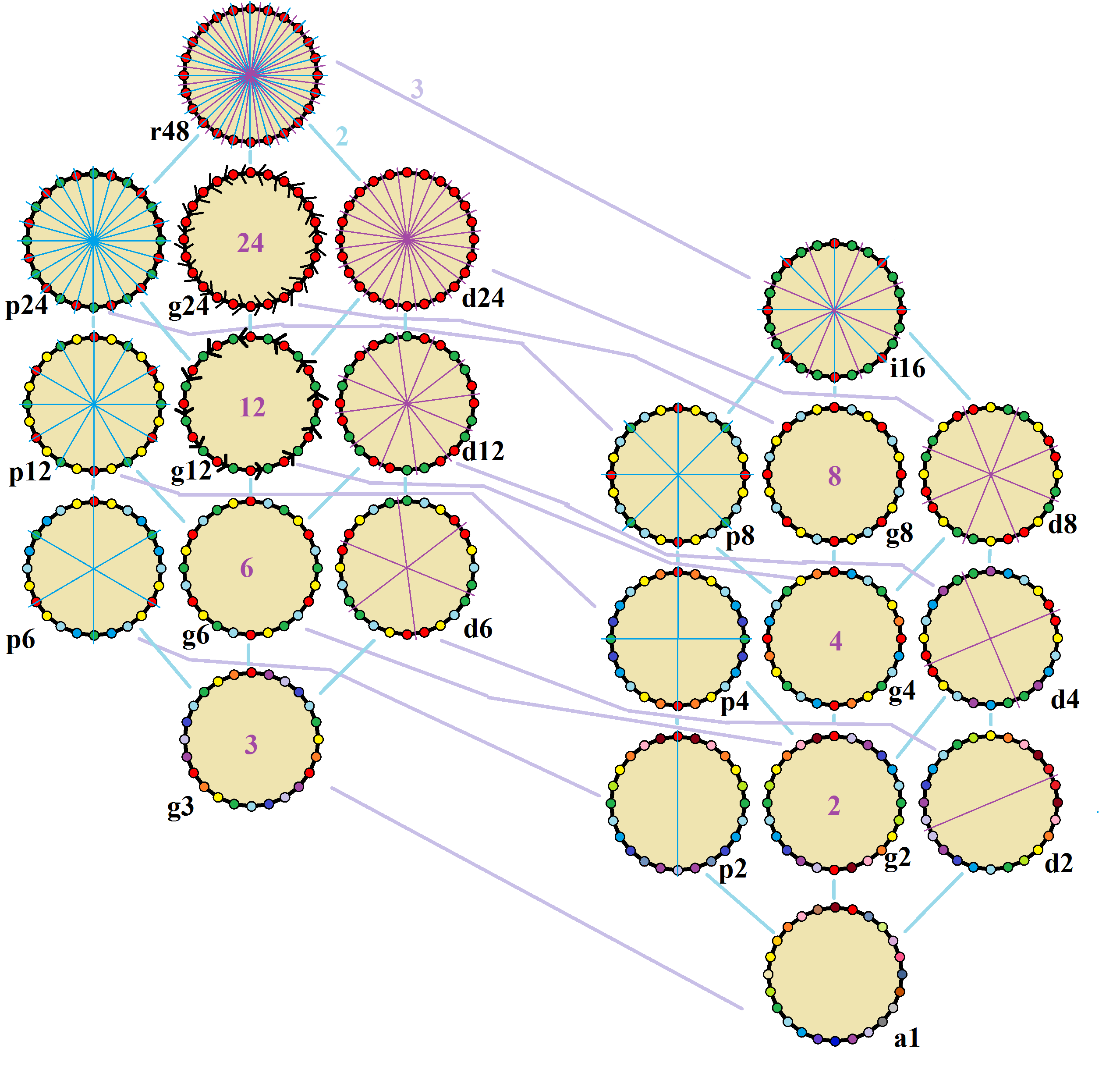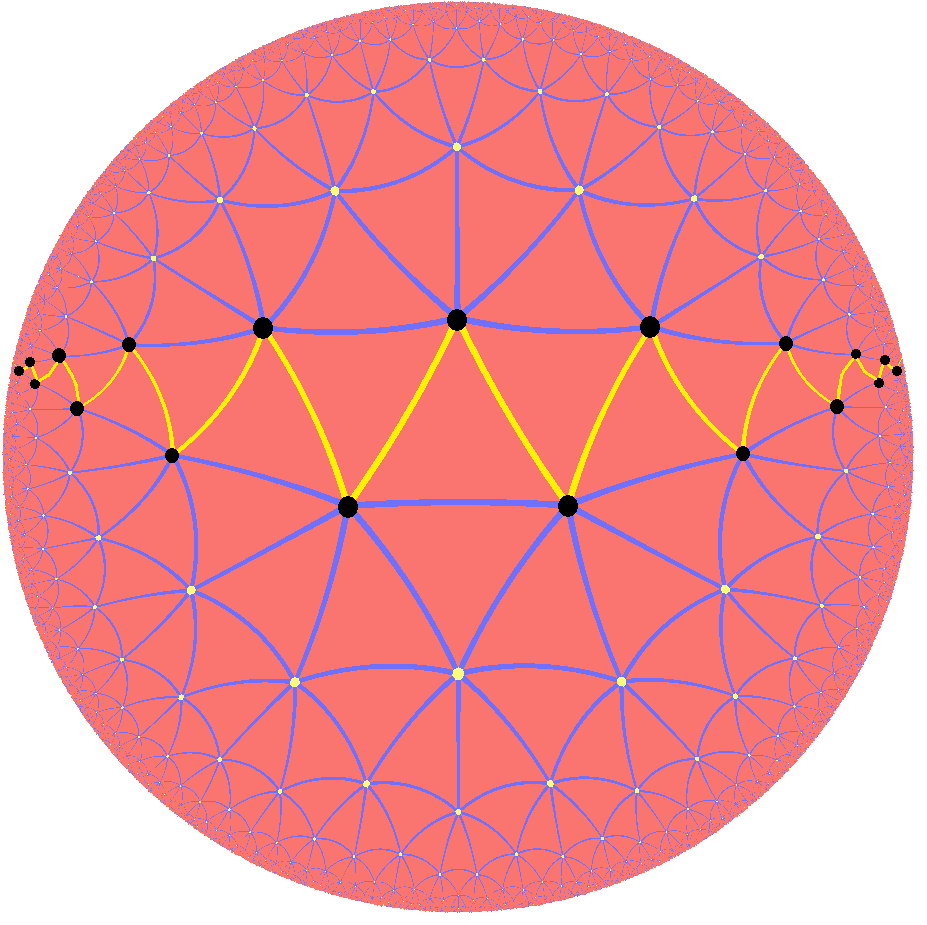|
Icositetragon
In geometry, an icositetragon (or icosikaitetragon) or 24-gon is a twenty-four-sided polygon. The sum of any icositetragon's interior angles is 3960 degrees. Regular icositetragon The ''regular polygon, regular icositetragon'' is represented by Schläfli symbol and can also be constructed as a Truncation (geometry), truncated dodecagon, t, or a twice-truncated hexagon, tt, or thrice-truncated triangle, ttt. One interior angle in a regular polygon, regular icositetragon is 165°, meaning that one exterior angle would be 15°. The area of a regular icositetragon is: (with ''t'' = edge length) : A = 6t^2 \cot \frac = t^2(2+\sqrt+\sqrt+\sqrt). The icositetragon appeared in Archimedes' polygon approximation of pi, along with the hexagon (6-gon), dodecagon (12-gon), tetracontaoctagon (48-gon), and enneacontahexagon (96-gon). Construction As 24 = 23 × 3, a regular icositetragon is constructible polygon, constructible using a compass and straightedge. As a truncated dodecagon, it ca ... [...More Info...] [...Related Items...] OR: [Wikipedia] [Google] [Baidu] |
Polygon
In geometry, a polygon () is a plane figure made up of line segments connected to form a closed polygonal chain. The segments of a closed polygonal chain are called its '' edges'' or ''sides''. The points where two edges meet are the polygon's '' vertices'' or ''corners''. An ''n''-gon is a polygon with ''n'' sides; for example, a triangle is a 3-gon. A simple polygon is one which does not intersect itself. More precisely, the only allowed intersections among the line segments that make up the polygon are the shared endpoints of consecutive segments in the polygonal chain. A simple polygon is the boundary of a region of the plane that is called a ''solid polygon''. The interior of a solid polygon is its ''body'', also known as a ''polygonal region'' or ''polygonal area''. In contexts where one is concerned only with simple and solid polygons, a ''polygon'' may refer only to a simple polygon or to a solid polygon. A polygonal chain may cross over itself, creating star polyg ... [...More Info...] [...Related Items...] OR: [Wikipedia] [Google] [Baidu] |
Compass And Straightedge
In geometry, straightedge-and-compass construction – also known as ruler-and-compass construction, Euclidean construction, or classical construction – is the construction of lengths, angles, and other geometric figures using only an Idealization (science philosophy), idealized ruler and a Compass (drawing tool), compass. The idealized ruler, known as a straightedge, is assumed to be infinite in length, have only one edge, and no markings on it. The compass is assumed to have no maximum or minimum radius, and is assumed to "collapse" when lifted from the page, so it may not be directly used to transfer distances. (This is an unimportant restriction since, using a multi-step procedure, a distance can be transferred even with a collapsing compass; see compass equivalence theorem. Note however that whilst a non-collapsing compass held against a straightedge might seem to be equivalent to marking it, the neusis construction is still impermissible and this is what unmarked really ... [...More Info...] [...Related Items...] OR: [Wikipedia] [Google] [Baidu] |
Geometry
Geometry (; ) is a branch of mathematics concerned with properties of space such as the distance, shape, size, and relative position of figures. Geometry is, along with arithmetic, one of the oldest branches of mathematics. A mathematician who works in the field of geometry is called a ''List of geometers, geometer''. Until the 19th century, geometry was almost exclusively devoted to Euclidean geometry, which includes the notions of point (geometry), point, line (geometry), line, plane (geometry), plane, distance, angle, surface (mathematics), surface, and curve, as fundamental concepts. Originally developed to model the physical world, geometry has applications in almost all sciences, and also in art, architecture, and other activities that are related to graphics. Geometry also has applications in areas of mathematics that are apparently unrelated. For example, methods of algebraic geometry are fundamental in Wiles's proof of Fermat's Last Theorem, Wiles's proof of Fermat's ... [...More Info...] [...Related Items...] OR: [Wikipedia] [Google] [Baidu] |
Vertex Arrangement
In geometry, a vertex arrangement is a set of points in space described by their relative positions. They can be described by their use in polytopes. For example, a ''square vertex arrangement'' is understood to mean four points in a plane, equal distance and angles from a center point. Two polytopes share the same ''vertex arrangement'' if they share the same 0-skeleton. A group of polytopes that shares a vertex arrangement is called an ''army''. Vertex arrangement The same set of vertices can be connected by edges in different ways. For example, the ''pentagon'' and ''pentagram'' have the same ''vertex arrangement'', while the second connects alternate vertices. A ''vertex arrangement'' is often described by the convex hull polytope which contains it. For example, the regular ''pentagram'' can be said to have a (regular) ''pentagonal vertex arrangement''. Infinite tilings can also share common ''vertex arrangements''. For example, this triangular lattice of points ... [...More Info...] [...Related Items...] OR: [Wikipedia] [Google] [Baidu] |
Star Polygon
In geometry, a star polygon is a type of non-convex polygon. Regular star polygons have been studied in depth; while star polygons in general appear not to have been formally defined, Decagram (geometry)#Related figures, certain notable ones can arise through truncation operations on regular simple or star polygons. Branko Grünbaum identified two primary usages of this terminology by Johannes Kepler, one corresponding to the regular star polygons with List of self-intersecting polygons, intersecting edges that do not generate new vertices, and the other one to the isotoxal Concave polygon, concave simple polygons.Grünbaum & Shephard (1987). Tilings and Patterns. Section 2.5 Polygram (geometry), Polygrams include polygons like the pentagram, but also compound figures like the hexagram. One definition of a ''star polygon'', used in turtle graphics, is a polygon having ''q'' ≥ 2 Turn (geometry), turns (''q'' is called the turning number or Density (polygon), density), like in ... [...More Info...] [...Related Items...] OR: [Wikipedia] [Google] [Baidu] |
24-gon Rhombic Dissectionx
In geometry a quadrilateral is a four-sided polygon, having four edges (sides) and four corners (vertices). The word is derived from the Latin words ''quadri'', a variant of four, and ''latus'', meaning "side". It is also called a tetragon, derived from Greek "tetra" meaning "four" and "gon" meaning "corner" or "angle", in analogy to other polygons (e.g. pentagon). Since "gon" means "angle", it is analogously called a quadrangle, or 4-angle. A quadrilateral with vertices A, B, C and D is sometimes denoted as \square ABCD. Quadrilaterals are either simple (not self-intersecting), or complex (self-intersecting, or crossed). Simple quadrilaterals are either convex or concave. The interior angles of a simple (and planar) quadrilateral ''ABCD'' add up to 360 degrees, that is :\angle A+\angle B+\angle C+\angle D=360^. This is a special case of the ''n''-gon interior angle sum formula: ''S'' = (''n'' − 2) × 180° (here, n=4). All non-self-crossing quadrilaterals tile the p ... [...More Info...] [...Related Items...] OR: [Wikipedia] [Google] [Baidu] |
12-cube
In geometry, a hypercube is an ''n''-dimensional analogue of a square ( ) and a cube ( ); the special case for is known as a ''tesseract''. It is a closed, compact, convex figure whose 1-skeleton consists of groups of opposite parallel line segments aligned in each of the space's dimensions, perpendicular to each other and of the same length. A unit hypercube's longest diagonal in ''n'' dimensions is equal to \sqrt. An ''n''-dimensional hypercube is more commonly referred to as an ''n''-cube or sometimes as an ''n''-dimensional cube. The term measure polytope (originally from Elte, 1912) is also used, notably in the work of H. S. M. Coxeter who also labels the hypercubes the γn polytopes. The hypercube is the special case of a hyperrectangle (also called an ''n-orthotope''). A ''unit hypercube'' is a hypercube whose side has length one unit. Often, the hypercube whose corners (or ''vertices'') are the 2''n'' points in R''n'' with each coordinate equal to 0 or 1 is call ... [...More Info...] [...Related Items...] OR: [Wikipedia] [Google] [Baidu] |
Petrie Polygon
In geometry, a Petrie polygon for a regular polytope of dimensions is a skew polygon in which every consecutive sides (but no ) belongs to one of the facets. The Petrie polygon of a regular polygon is the regular polygon itself; that of a regular polyhedron is a skew polygon such that every two consecutive sides (but no three) belongs to one of the faces. Petrie polygons are named for mathematician John Flinders Petrie. For every regular polytope there exists an orthogonal projection onto a plane such that one Petrie polygon becomes a regular polygon with the remainder of the projection interior to it. The plane in question is the Coxeter plane of the symmetry group of the polygon, and the number of sides, , is the Coxeter number of the Coxeter group. These polygons and projected graphs are useful in visualizing symmetric structure of the higher-dimensional regular polytopes. Petrie polygons can be defined more generally for any embedded graph. They form the faces of ano ... [...More Info...] [...Related Items...] OR: [Wikipedia] [Google] [Baidu] |
Zonogon
In geometry, a zonogon is a centrally-symmetric, convex polygon. Equivalently, it is a convex polygon whose sides can be grouped into parallel pairs with equal lengths and opposite orientations, the two-dimensional analog of a zonohedron. Examples A regular polygon is a zonogon if and only if it has an even number of sides. Thus, the square, regular hexagon, and regular octagon are all zonogons. The four-sided zonogons are the square, the rectangles, the rhombi, and the parallelograms. Tiling and equidissection The four-sided and six-sided zonogons are parallelogons, able to tile the plane by translated copies of themselves, and all convex parallelogons have this form. Every 2n-sided zonogon can be tiled by \tbinom parallelograms. (For equilateral zonogons, a 2n-sided one can be tiled by \tbinom rhombi.) In this tiling, there is a parallelogram for each pair of slopes of sides in the 2n-sided zonogon. At least three of the zonogon's vertices must be vertices of only one of t ... [...More Info...] [...Related Items...] OR: [Wikipedia] [Google] [Baidu] |






